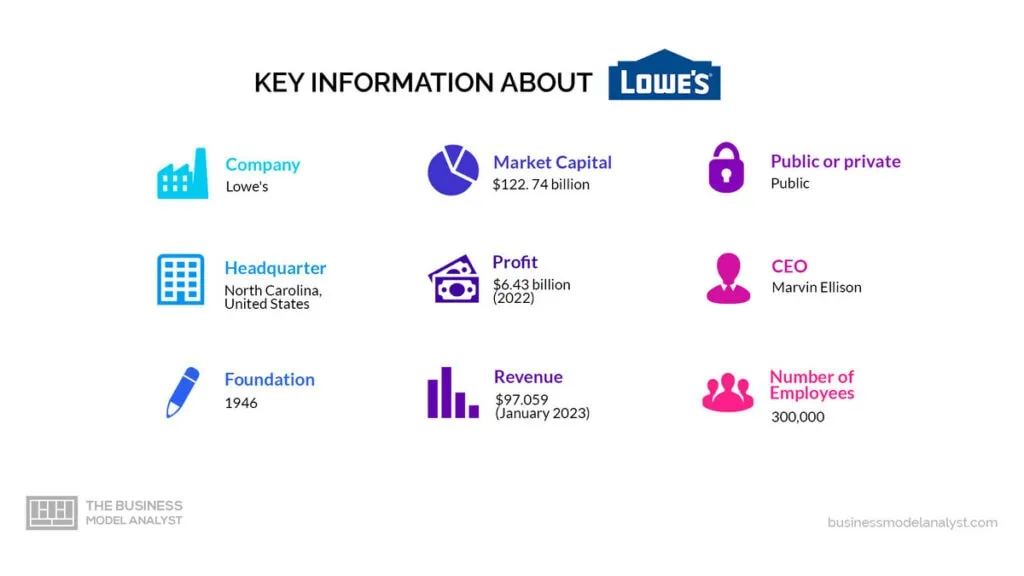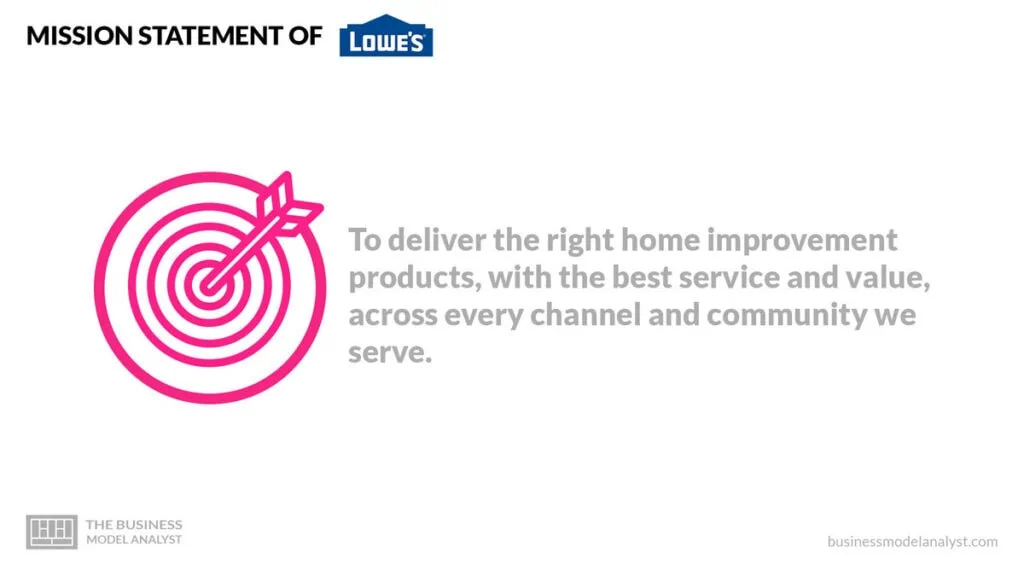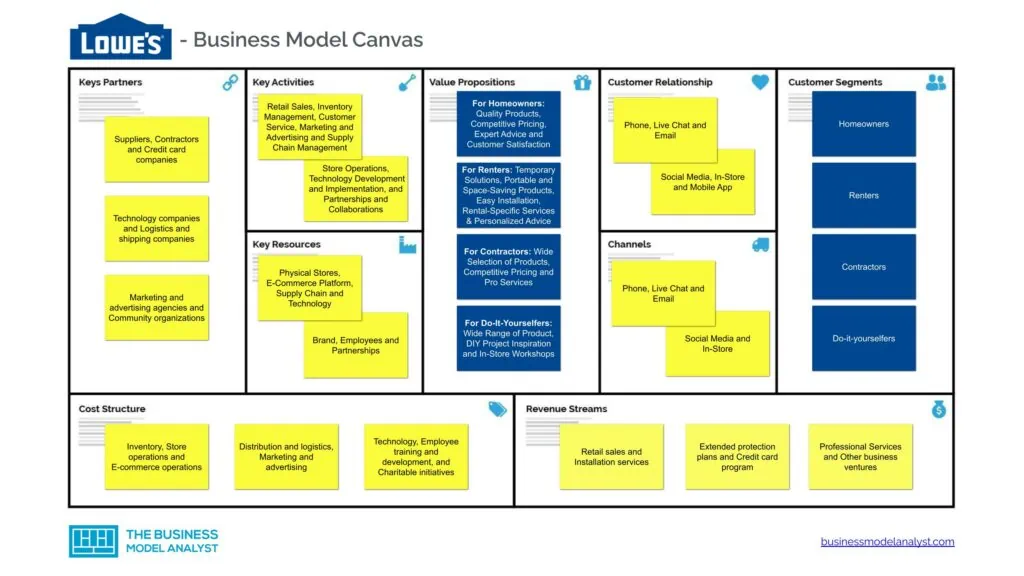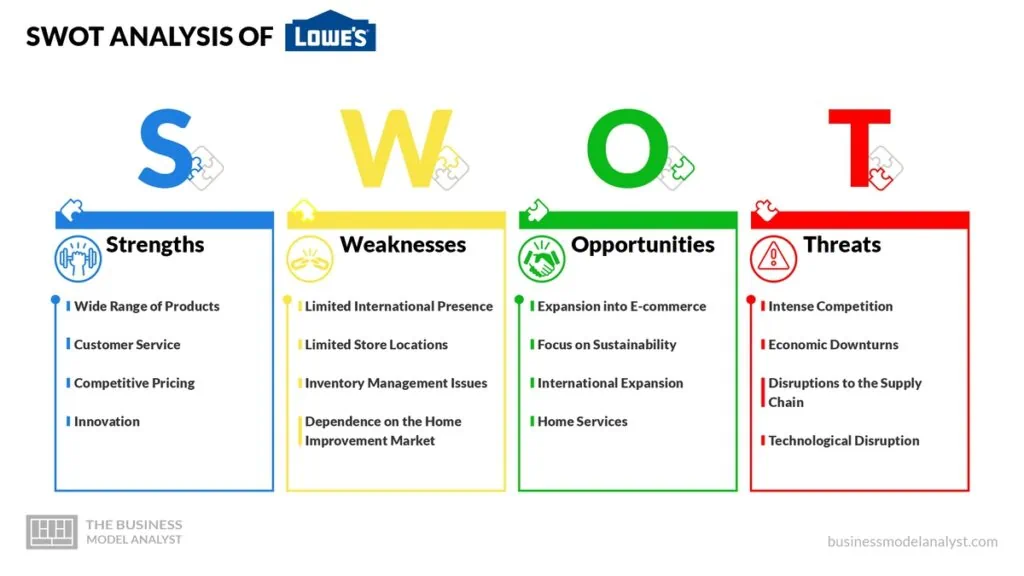The Lowe’s business model provides a broad range of products for homeowners and contractors at competitive prices. Lowe operates more than 1,700 stores across North America and has a significant online presence. The company’s core products include appliances, building materials, home décor, and gardening supplies, but Lowe’s also offers installation and repair services to differentiate itself from competitors further. Overall, Lowe’s focus on customer satisfaction, convenience, and innovation has helped it establish a strong market position in the home improvement industry.

Contents
A brief history of Lowe’s
Lowe is a home improvement retailer founded in 1946 by Lucius Smith Lowe in North Wilkesboro, North Carolina. The company is headquartered in Mooresville, North Carolina, with over 2,200 stores across the United States, Canada, and Mexico. In the early days, Lowe’s was a small hardware store that primarily sold tools and building supplies to farmers and construction workers. However, the company quickly expanded its offerings and began to stock a more comprehensive range of products to appeal to a broader customer base.
One of the early successes of Lowe’s was its introduction of pre-cut lumber, which made it easier for customers to purchase building materials for their projects. The company also became known for its competitive pricing and commitment to customer service, which helped to establish its reputation as a reliable retailer. However, like many businesses, Lowe’s also experienced some failures in its early years. In the 1950s, the company attempted to expand its operations by opening several new stores in different locations. However, these stores were less successful than the original North Wilkesboro location, forcing the company to close many of them.
Despite these setbacks, Lowe’s continued to grow and eventually became one of the largest home improvement retailers in the United States. By the 1990s, the company had expanded into new markets, including Canada and Mexico, and had begun to offer a broader range of products and services. Today, Lowe’s is known for its extensive selection of home improvement products, including appliances, flooring, lighting, and more. The company also offers various services to help customers with their projects, including installation, repair, and maintenance.
Lowe’s Canada stands as a top choice among homeowners when it comes to any products for DIY projects, especially window replacement, rivalling even Home Depot in popularity.
This preference is largely attributed to Lowe’s extensive selection of mass-produced windows catering to diverse needs and preferences. Homeowners are drawn to Lowe’s for its reputation as a one-stop shop for home improvement, offering both variety and convenience. This has positioned Lowe’s as a formidable competitor to specialized window companies like Ecoline Windows and others in Canada.
The reason behind Lowe’s edge in this market segment lies in its ability to leverage its vast network and purchasing power to offer a wide range of affordable yet quality window options. This accessibility and affordability make Lowe’s an attractive destination for those embarking on major home renovations, including window upgrades.
Lowe’s has been recognized for its commitment to sustainability and has made significant efforts to reduce its environmental impact. The company has implemented energy-efficient practices in its stores and distribution centers, and has also developed programs to promote recycling and waste reduction. In terms of customer base, Lowe’s serves a diverse range of customers, including homeowners, contractors, and commercial customers. The company has also tried appealing to a younger demographic through its online presence and social media marketing.
Lowe’s has a rich history of growth and innovation in the home improvement industry. From its humble beginnings as a small hardware store in North Carolina to its current status as a global retailer, the company has remained committed to providing quality products and services to its customers
Who Owns Lowe’s
Lowe’s Companies, Inc. is a publicly-traded company on the New York Stock Exchange (NYSE) owned by its shareholders. The largest institutional shareholders of Lowe’s are The Vanguard Group, BlackRock, State Street Global Advisors, and Capital World Investors. The current CEO of Lowe’s is Marvin Ellison, who has held the position since July 2018.
Lowe’s Mission Statement

Lowe’s mission statement is “to deliver the right home improvement products, with the best service and value, across every channel and community we serve.”
How Lowe’s works
Lowe’s is a home improvement retailer that sells various products, including appliances, tools, hardware, building supplies, and home decor. The company operates both brick-and-mortar stores and an online store. The stores typically have multiple departments, each offering products in a specific category. For example, there may be a paint department, a lumber department, a plumbing department, and a garden center. Each department is staffed by knowledgeable associates who can advise and assist customers.
When a customer enters a Lowe’s store, they can browse the products on display, ask questions of the associates, and purchase the items they need. Alternatively, customers can shop online through the Lowe’s website, which offers a similar selection of products. Once customers have selected the items they wish to purchase, they can proceed to the checkout to pay for their order. Lowe’s accepts various payment methods, including credit cards, debit cards, and cash.
Lowe’s also offers a range of services to its customers, such as installation and repair services for specific products. Additionally, the company has a customer loyalty program called MyLowe’s, which provides members with discounts, personalized shopping experiences, and other benefits.
How Lowe’s makes money

Lowe’s Companies, Inc., a home improvement retailer in the United States, generates revenue from a variety of sources, including:
Retail sales
Lowe’s generates revenue from selling various home improvement products such as appliances, tools, hardware, building materials, home decor, etc. This is the primary source of income for the company.
Installation services
Lowe’s offers installation services for many products, such as flooring, windows, doors, and appliances. This is an additional revenue stream for the company.
Extended protection plans
Lowe’s offers extended protection plans for many of the products it sells, which provides customers with additional coverage beyond the manufacturer’s warranty. This is a source of recurring revenue for the company.
Credit card program
Lowe’s has a credit card program allowing customers to finance purchases and earn rewards. The company earns revenue from interest and fees associated with the program.
Professional services
Lowe’s offers professional services such as painting, plumbing, and electrical work through its network of independent contractors. This is another source of revenue for the company.
Other business ventures
Lowe’s engages in other business ventures, such as partnerships with other companies or developing new products or services, providing additional revenue sources.
Lowe’s Business Model Canvas
The Lowe’s Business Model can be explained in the following business model canvas:

Lowe’s Customer Segments
Lowe’s customer segments are:
- Homeowners
- Renters
- Contractors
- Do-it-yourselfers (DIYers)
- Professionals
Lowe’s Value Propositions
Lowe’s value propositions are:
Value Propositions for Homeowners:
- Quality Products: Lowe’s offers a wide variety of high-quality products for homeowners, including appliances, tools, flooring, lighting, and hardware. These products are sourced from reputable manufacturers and are designed to meet the needs of homeowners;
- Competitive Pricing: The company offers competitive pricing on its products to provide homeowners with value for their money. It regularly offers discounts and promotions to help customers save on their purchases;
- Expert Advice: Lowe’s employs knowledgeable staff who can advise homeowners on various home improvement topics. Customers can ask for guidance on everything from selecting the right product to completing a DIY project;
- Customer Satisfaction: Lowe’s is committed to customer satisfaction and offers a range of customer-friendly policies, such as hassle-free returns and a price match guarantee, to ensure that homeowners are satisfied with their purchases.
Value Propositions for Renters:
- Temporary Solutions: Lowe’s offers a range of temporary solutions that are ideal for renters who are not able to make permanent changes to their living space. These include removable wallpaper, stick-on tiles, and temporary shelving options;
- Portable and Space-Saving Products: Renters often have limited space to work with, so Lowe’s offers a variety of portable and space-saving products, such as compact furniture, modular shelving, and storage solutions that can be easily moved or reconfigured as needed;
- Easy Installation: Lowe’s offers products that are easy to install and remove, making them ideal for renters who may need to move frequently. These products include window treatments, door locks, and light fixtures;
- Rental-Specific Services: Lowe’s offers rental-specific services such as truck rentals and tool rentals to help renters tackle home improvement projects without investing in expensive equipment;
- Personalized Advice: Lowe’s employs knowledgeable staff who can provide customized advice to renters on how to make improvements to their living space that are both practical and affordable. Customers can ask for guidance on everything from organizing small spaces to maximizing storage.
Value Propositions for Contractors:
- Wide Selection of Products: Lowe’s has a wide selection of products for contractors, including building materials, tools, and equipment. The products are from reputable manufacturers that are of high quality and designed to meet the needs of professionals;
- Competitive Pricing: Lowe’s strives to offer competitive pricing on its products to provide contractors with value for their money. The company regularly offers discounts and promotions to help professionals save on purchases;
- Pro Services: Lowe’s offers services explicitly tailored to contractors, including dedicated account managers, volume discounts, and delivery and pickup options. These services help contractors save time and money by streamlining their purchasing process and supporting their projects.
Value Propositions for Do-It-Yourselfers:
- Wide Range of Products: Lowe’s offers a wide range of products designed for DIYers, including power tools, hand tools, and building materials. The company offers products from trusted brands that are of high quality and designed to meet the needs of DIYers;
- DIY Project Inspiration: the company provides DIYers with project inspiration and resources to help them plan and execute their home improvement projects. This includes how-to guides, videos, and project ideas on Lowe’s website or in-store;
- In-Store Workshops: Lowe’s offers in-store workshops for DIYers of all skill levels. These workshops provide hands-on instruction and guidance for various projects, such as tiling, woodworking, and painting. DIYers can also ask questions and get advice from knowledgeable staff members.
Value Propositions for Professionals:
- Pro Services: Lowe’s provides dedicated services to professionals, including specialized support and a dedicated account manager. This allows professionals to streamline their purchasing process and get the support they need to complete their projects on time and budget;
- Delivery and Pickup Options: Lowe’s offers delivery and pickup options designed for professionals transporting large quantities of building materials, tools, and equipment. This includes next-day delivery, in-store pickup, and curbside pickup options;
- Volume Discounts: Lowe’s provides volume discounts to professionals who purchase large quantities of products regularly. This allows professionals to save money on purchases and reduce overall project costs. Additionally, Lowe’s offers a Pro Loyalty Program that provides exclusive benefits and rewards to loyal professional customers.
Lowe’s Channels
Lowe’s channels are:
- Phone
- Live Chat
- Social Media
- In-Store
Lowe’s Customer Relationships
Lowe’s customer relationships comprise:
- Phone
- Live Chat
- Social Media
- In-Store
- Mobile App
Lowe’s Revenue Streams
Lowe’s revenue streams are:
- Retail sales
- Installation services
- Extended protection plans
- Credit card program
- Professional Services
- Other business ventures
Lowe’s Key Resources
Lowe’s key resources include:
- Physical Stores
- E-Commerce Platform
- Supply Chain
- Technology
- Brand
- Employees
- Partnerships
Lowe’s Key Activities
Lowe’s key activities include:
- Retail Sales
- Inventory Management
- Customer Service
- Marketing and Advertising
- Supply Chain Management
- Store Operations
- Technology Development and Implementation
- Partnerships and Collaborations
Lowe’s Key Partners
Lowe’s key partners include:
- Suppliers
- Contractors
- Credit card companies
- Technology companies
- Logistics and shipping companies
- Marketing and advertising agencies
- Community organizations
Lowe’s Cost Structure
Lowe’s cost structure includes :
- Inventory
- Store operations
- E-commerce operations
- Distribution and logistics
- Marketing and advertising
- Technology
- Employee training and development
- Charitable initiatives
Lowe’s Competitors
- The Home Depot: Founded in 1978 by Bernie Marcus, Arthur Blank, Ron Brill, and Pat Farrah, The Home Depot is an American home improvement retailer with its headquarters in Atlanta, Georgia. The company had over 2,000 stores in the U.S., Canada, and Mexico and employed over 500,000 people. It serves consumers and professionals, offering various products, including building materials, tools, and appliances. The company’s online store also provides multiple delivery options and DIY project ideas, making it a one-stop shop for home improvement needs;
- Menards: Founded in 1958 by John Menard Jr., Menards is a privately held chain of home improvement stores with its headquarters in Eau Claire, Wisconsin. It has over 300 stores in the Midwestern United States and employs over 45,000 people. The company is known for its large selection of products, including building materials, tools, and home decor, at competitive prices. Menards also offers various services, such as installation and delivery, to help customers complete home improvement projects;
- Ace Hardware: Ace Hardware was founded in 1924 by Richard Hesse, E. Gunnard Lindquist, Frank Burke, Oscar Fisher, and William Stauber. It is a cooperative of independently owned and operated hardware stores. The company has its headquarters in Oak Brook, Illinois, and has over 5,300 stores located in over 70 countries. Ace Hardware offers various products, including hardware, tools, and outdoor essentials. The company is known for its helpful and knowledgeable staff and commitment to supporting local communities;
- True Value: Founded in 1948 by John Cotter, True Value is another cooperative of independently owned and operated hardware stores headquartered in Chicago, Illinois. The company has over 4,400 stores in over 60 countries and is known for its focus on customer service and community involvement. True Value offers a variety of products, including hardware, tools, and outdoor living essentials, and provides services such as rental equipment and assembly services;
- Walmart: Walmart was founded in 1962 by Sam Walton. It is an American multinational retail corporation headquartered in Bentonville, Arkansas. While Walmart is primarily known as a general merchandise retailer, the company also offers a wide range of home improvement products, including building materials, tools, and appliances. Walmart has over 11,000 stores in over 25 countries and employs over 2.3 million people worldwide. The company’s focus on low prices and convenient shopping options, such as curbside pickup and free two-day shipping, make it a popular choice for customers looking to complete their home improvement projects on a budget.
Lowe’s SWOT Analysis
Below, there is a detailed swot analysis of Lowe’s:

Lowe’s Strengths
- Wide Range of Products: Lowe’s has a vast selection of products ranging from appliances, tools, hardware, building materials, and home decor. This allows customers to find everything they need for their home improvement projects under one roof;
- Customer Service: Known for its exceptional customer service, Lowe’s has knowledgeable staff who can help customers with their queries and guide them through their purchases. Additionally, they offer online and in-store resources, such as DIY workshops and tutorials, to assist customers with their projects;
- Competitive Pricing: Lowe’s is known for offering competitive product pricing. They regularly offer sales, discounts, and promotions, which make their products more affordable for customers;
- Innovation: The company invests in innovation and technology to enhance the shopping experience for customers. They have introduced augmented reality tools to help customers visualize products in their homes and offer online ordering and delivery options for convenience. Lowe’s also uses eco-friendly practices and products to promote sustainability.
Lowe’s Weaknesses
- Limited International Presence: Lowe’s has a limited international presence compared to its main competitor, Home Depot. This limits the company’s potential for growth and revenue generation in markets outside the United States;
- Limited Store Locations: While Lowe’s has over 1,700 stores in the United States, its store footprint is smaller than Home Depot’s. This limits the company’s accessibility for customers who may not have a store nearby;
- Inventory Management Issues: Lowe’s has faced inventory management issues, leading to overstocking and understocking of certain products. This can lead to lost sales and decreased customer satisfaction;
- Dependence on the Home Improvement Market: Lowe’s heavily relies on the home improvement market for its revenue generation. Economic downturns and fluctuations in the housing market can significantly impact the company’s sales and profitability.
Lowe’s Opportunities
- Expansion into E-commerce: Lowe’s has an opportunity to expand its e-commerce capabilities and reach a wider audience through online channels. This includes investing in online marketing and advertising, improving its online platform, and offering faster and more convenient delivery options;
- Focus on Sustainability: As more consumers become environmentally conscious, Lowe’s can capitalize on this trend by offering eco-friendly products and promoting sustainable practices. This includes offering energy-efficient appliances, promoting recycling and waste reduction, and using sustainable materials in its products;
- International Expansion: Lowe’s can expand its operations into new global markets to diversify its revenue streams and tap into new customer bases. This involves opening new stores or partnering with existing retailers in new regions;
- Home Services: Lowe’s can expand its home services offerings to provide a more comprehensive solution to customers. This includes installing and repairing services for appliances, HVAC systems, and other home products, as well as home remodeling and renovation services.
Lowe’s Threats
- Intense Competition: Lowe’s faces fierce competition from other home improvement retailers, such as Home Depot, Menards, and Ace Hardware. These competitors have a similar range of products and customer base, leading to price wars and decreased profitability;
- Economic Downturns: Lowe’s is vulnerable to economic downturns, as customers may cut back on home improvement projects during financial uncertainty. This leads to decreased sales and revenue;
- Disruptions to the Supply Chain: Lowe’s depends on a global supply chain for its products, which can be impacted by disruptions such as natural disasters, trade conflicts, and pandemics. These disruptions can lead to product shortages, price increases, and decreased customer satisfaction;
- Technological Disruption: As technology advances, Lowe’s faces the threat of disruption from new players in the market. For example, startups that specialize in home automation, smart home products, and online home design could pose a threat to Lowe’s traditional business model.
Conclusion
Lowe’s is a leading home improvement retailer with a wide range of products, exceptional customer service, and a focus on sustainability. However, the company faces several challenges, including intense competition, economic downturns, and supply chain disruptions.
Despite these challenges, Lowe’s has several opportunities to grow and diversify its operations, including expanding its e-commerce capabilities, focusing on sustainability, and expanding its home services offerings. By capitalizing on these opportunities and addressing its weaknesses and threats, Lowe’s can remain a significant player in the home improvement industry and continue to provide value to its customers.

